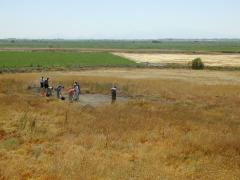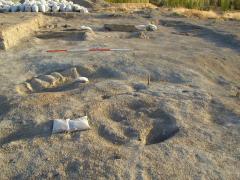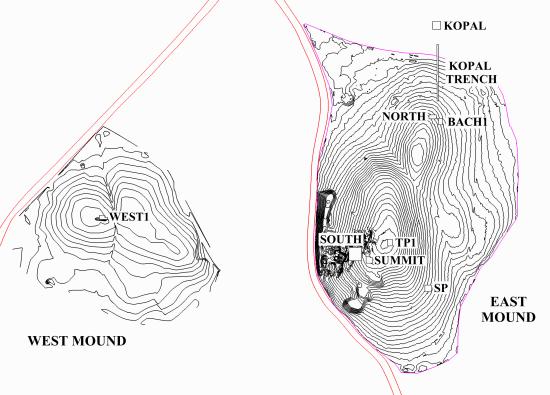Excavations on SP and TP1
Shahina FaridTwo new areas were investigated on the East Mound in preparation for the arrival of a new excavation team at Çatalhöyük proposed for the 2001 season.
|
The first area (SP) investigated by a team of Selçuk University (Konya) students was situated to the south on the East Mound (Figure 6). This area was targeted on the basis of the results of a gradiometer survey conducted in 1995. This survey indicated a large rectilinear feature of a size not previously encountered, possibly indicating a large mudbrick structure c. 8. m square. It was interpreted as mudbrick walls of up to 1 metre wide and although possibly of post-Neolithic date, it was of interest because it's orientation was the same as an area of Neolithic buildings a few metres to the northeast. Prior to this no scrape squares had been conducted on the southern lower slopes of the East Mound. This was therefore the first opportunity to investigate this location and accordingly a 10 x 10 m square was opened. |
 Figure 8: Excavation on the southern slopes of the East Mound (SP) |
Archaeology was encountered about 0.5m below topsoil in the SW quadrant and consisted of mudbrick walls of the Classical Period. A pit cut a corner of the wall and there were also the basal remains of a hearth. All associated dating material was of the Classical Period. Although the large structure that had shown up in the gradiometer survey was not defined the horizon reached was recorded and backfilled as the aim was not to excavate these late periods.
 Figure 7: Classical Period features revealed near the East Mound summit (TP1) |
A second area (TP1) was cleared, at the crest of the East Mound, immediately east of James Mellaart's Area A. This was the area where Mellaart excavated the latest building levels at the site, Levels I and II. To date the current project has concentrated on excavation of the middle and lower levels but nothing of the upper levels. The initial area yielded classical activity and a number of associated burials. The burials were in extended positions within mudbrick lined burial cuts. The presence of this activity made it difficult to pursue the original objective of defining the Neolithic activity without excavation of the overlying classical deposits. This area was therefore also recorded and backfilled. |
Investigations were then moved north into Mellaart's trench. The archaeology exposed in section and plan comprised Levels I, II and III. In plan there were a combination of Levels II and III mudbrick walls concentrated to the east on a N - S alignment. To the west of these structures was an area of heavily disturbed midden type deposits. One of the mudbrick walls defined in the east section could either represent Neolithic Level I or a structure from the Classical Period. In the NE section a small clay lined oven was associated with thick white pebble and plaster floor, this is also probably of the Classical Period.
The aim for 2001 therefore is to locate a trench immediately to the east of Mellaart's Area A, this will define the continuation of the Level I structures partially excavated in the 1960's. However it is clear that there is overlying late activity which will first require excavation.

Figure 6: Çatalhöyük Excavation Areas